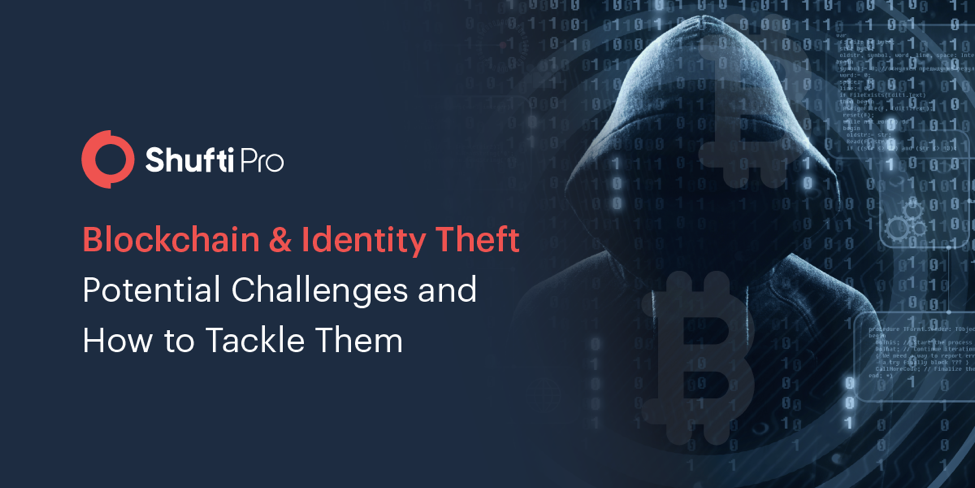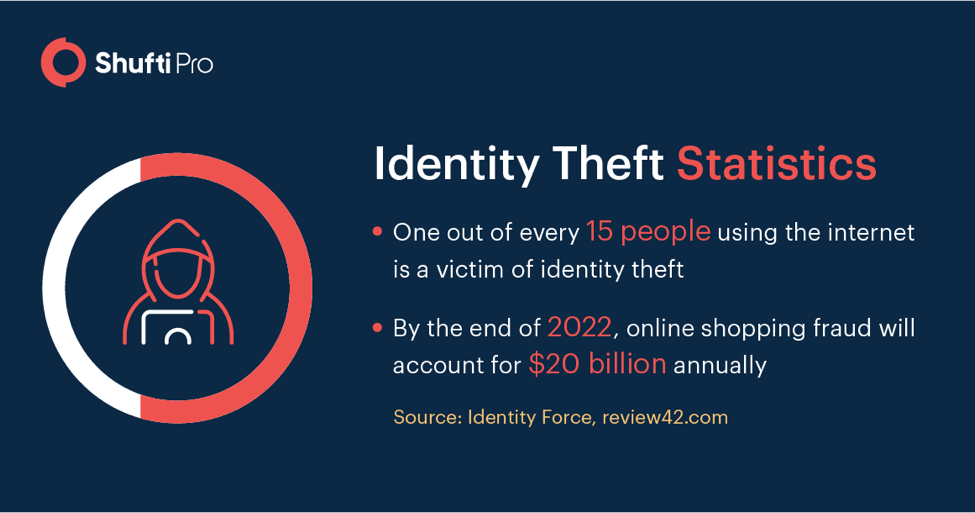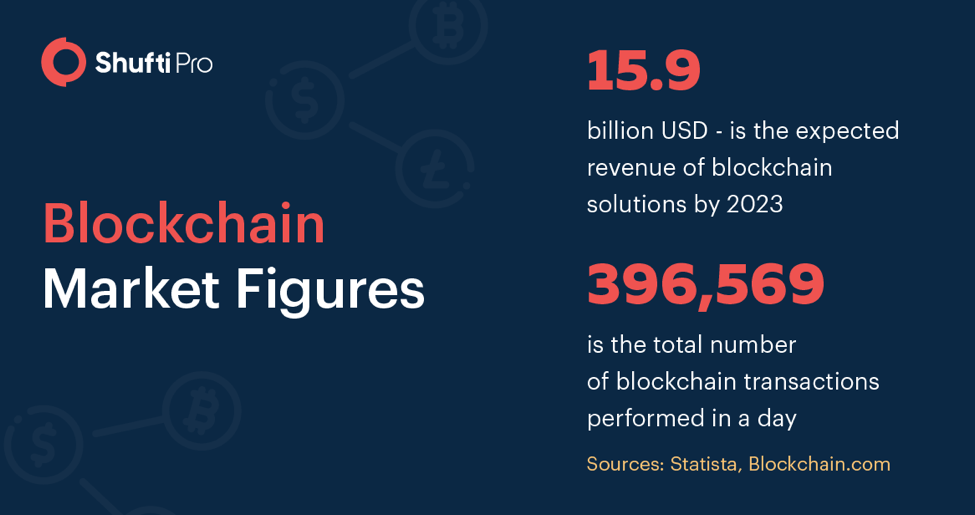Blockchain and Identity Theft: Potential Challenges and how to Tackle Them

Blockchain has become increasingly popular because of its potential to provide secure transactions and prevent identity theft. A staggering $20 billion is expected in annual blockchain spending with the finance sector contributing almost $522 billion to the overall sum. So what’s all the hype about? The power to privately store user data makes blockchain a preferred choice for both customers and service providers.
Identity theft is a growing concern with almost 60 million individuals falling prey in the US alone. Imagine the size of stolen identities when scaled at a global level. Many are unaware of the fact that their identities have been stolen unless they happen to notice devastating results. Not having proper means to safeguard customer identity could cost online businesses in terms of both brand loyalty and reputation. Blockchain provides users with better control over personal information and a reliable means of preventing identity fraud.
What is Blockchain Technology?
Blockchain is a collection of systems to collect user information, store it in encrypted form on different blocks on the internet. The blocks are data centers which are connected in a chain with each other using cryptography – a method to secure public transactions. A distributed ledger is responsible for recording data against each transaction in the chain.
Identity Theft – A Challenge For Blockchain Enterprises
Identity theft takes a toll to customers as well as poses a serious threat to online businesses. Cybercriminals employ a number of methods including data breaches, account takeovers, and payment card fraud to pursue their illicit motives. Some of the most common instances of identity theft are listed below:
Synthetic Identity Fraud
Personal details from various users are combined to make a fake identity which is called synthetic identity theft. Usually, the process is carried out by mixing the fabricated data with the stolen records of authentic users. Fraudsters then use these new identities to perform various other fraudulent activities. For instance, online scammers setting up fake accounts to associate ties with online businesses and performing money laundering through them.

E-commerce Scams
Online shopping scams are common when buying products or services from digital platforms. Dubious identities are all over these e-commerce websites to steal payment card details by tricking consumers into submitting their identity information. Imposter e-stores are created with the purpose of stealing user information usually through phishing emails and attractive offers.
Medical Identity Theft
Health insurers and medical service providers need to keep a vigilant eye on clever fraudsters looking to steal the medical identity of patients. Medical ID theft can grant illegal access to a patient’s records which can be used by the criminal to gain financial gains. This type of fraud often goes unnoticed due to lack of proper identity verification mechanisms during patient registration and insurance claims.
Stolen Social Security Numbers
Social Security Numbers (SSNs) are another avenue of conducting identity theft. Consisting of nine digits, SSN is usually assigned to citizens at the time of birth as an identity proof. Fraudsters use them to conduct a series of online frauds including medical and child identity theft. Often, online scammers acquire security numbers to gain access to the victim’s financial information to create fake accounts and obtain tax refunds.
Blockchain on Preventing ID Theft
Blockchain technology comes with a few advantages to secure user data and prevent criminal identities from entering the system. Some of them are listed below:
Secure Channel for Transactions
Blockchain is often treated as a cybersecurity solution to tackle identity theft. It can help prevent personal data from getting in the hands of bad actors due to the level of security it provides. The distributed ledger in blockchain is a record-keeping database which holds digital records. The personal detail of every user on the ledger is secured by using cryptographic keys – a mechanism to encode data in machine readable form. It makes it quite hard for hackers and cybercriminals to break the keys and gain access to sensitive credentials.
In case an intruder enters the system, it is detected in real-time to take down the fraud attempt to mitigate potential loss. This way, users of online services can perform transactions through a safe and secure channel without the fear of identity theft. Distributed Ledger Technology (DLP) in blockchain can be combined with ID verification solutions to verify customer identities across multiple platforms. This not only reduces the risk of end-point vulnerabilities but also helps enterprises comply with the standard regulations for onboarding procedures.

Fraud Entry Barrier is Narrowed
Last year, almost 16.7 million people fell prey to identity theft in the US. In a centralized network, it is easy to breach the system and get away with it. A single point of failure in identity verification systems can lead to a loss of millions, providing unauthorized access to credit card pins, SSNs and other personally identifiable information to fraudsters. When it comes to blockchain, the scenario is quite different since fraudsters attempting to steal an identity need to go from one point to another which is intensive in time and effort.
Public Key Cryptography (PKI) in blockchain is used to create a digital infrastructure that is distributed over multiple blocks of data. The significance of PKI’s are twofold; they provide protection for each individual’s identity, and they deter mass data breaches from occurring.
Personal Data Ownership
Cybercriminals use synthetic identities to take over user accounts which are used in impersonation fraud to issue new credit cards and open bank accounts. Identity theft costs banks a good deal of money each year with the number increasing each year. This can result in bad credit scores, huge amounts of debts on credit cards, and red flags by financial regulators.
Blockchain helps overcome this problem by offering public keys, which are used to facilitate two parties in initiating a secure transaction. This gives user’s ownership of their data, for example, identity information like birth dates are put on a blockchain to identify a user. This adds an additional layer of security for online communications.
Shufti’s IDV for Blockchain
Identity theft prevention is essential for service providers of all kinds. Verifying customer identity helps save cybercrime costs and offers an easy solution to practice Know Your Customer (KYC) and Anti Money Laundering (AML) standards. Blockchain firms can adopt ID verification services to effortlessly onboard their customers in real-time.
Identity verification by Shufti helps services providers in the blockchain space to streamline their customer onboarding. By offering IDV solutions backed with Artificial Intelligence, blockchain businesses can comply with international KYC and AML standards and ensure customer trust and loyalty. With a remarkable accuracy rate of almost 98.67%, and a global coverage in 232 countries and territories, Shufti is providing Blockchain-based platforms and businesses with a seamless solution for verifying their customer’s identity.










